The iPhone 5 Performance Preview
by Anand Lal Shimpi on September 21, 2012 11:31 PM EST- Posted in
- Smartphones
- Apple
- Mobile
- SoCs
- iPhone 5
This morning we finally got our hands on Apple's iPhone 5. While we are eager to get started on battery life testing, that'll happen late tonight after a full day's worth of use and a recharge cycle. Meanwhile, we went straight to work on performance testing. As we've mentioned before, the A6 SoC makes use of a pair of Apple's own CPU cores that implement the ARMv7 ISA. These aren't vanilla Cortex A9s or Cortex A15s, but rather something of Apple's own design. For its GPU Apple integrated a PowerVR SGX543MP3 GPU running at higher clocks than the dual-core 543MP2 in the A5. The result is compute performance that's similar to the A5X in Apple's 3rd generation iPad, but with a smaller overall die area. The A6 has a narrower memory interface compared to the A5x (64-bits vs. 128-bits), but that makes sense given the much lower display resolution (0.7MP vs. 3.1MP).
As always, our performance analysis starts out on the CPU. Although we originally thought the A6 ran its two CPU cores at 1GHz, it looks like max clocks range between 800MHz and 1.2GHz depending on load. Geekbench reports clock speed at launch, which varied depending on CPU load. With an app download process in the background I got Geekbench to report a 1.2GHz clock speed, and with everything quiet in the background the A6 reported 800MHz after being queried. This isn't anything new as dynamic voltage/frequency adjustment is in all smartphones, but we do now have a better idea of the range.
The other thing I noticed is that without a network active I'm able to get another ~10% performance boost over the standard results while on a network. Take the BrowserMark results below for example, the first two runs are without the iPhone 5 being active on AT&T's network while the latter two are after I'd migrated my account over. The same was true for SunSpider performance, I saw numbers in the low 810ms range before I registered the device with AT&T.
Overall, the performance of the A6 CPU cores seems to be very good. The iPhone 4S numbers below are updated to iOS 6.0 so you can get an idea of performance improvement.
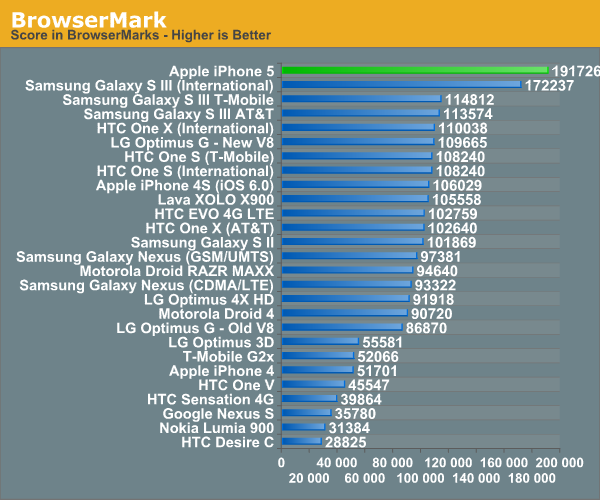
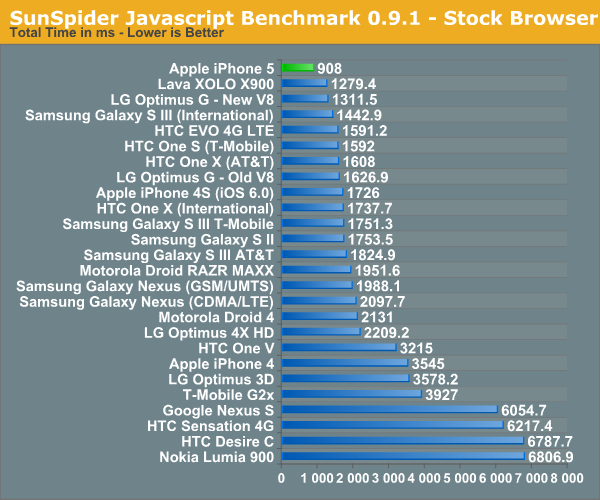
As we mentioned in our earlier post, SunSpider is a small enough benchmark that it really acts as a cache test. The memory interface on the A6 seems tangibly better than any previous ARM based design, and the advantage here even outpaces Intel's own Medfield SoC.
I also ran some data using Google's V8 and Octane benchmarks, both bigger JavaScript tests than SunSpider. I had an AT&T HTC One X with me while in New York today (up here for meetings this week) and included its results in the charts below. Note that the default HTC web browser won't run the full Octane suite so I used Chrome there. I didn't use Chrome for the V8 test because it produced lower numbers than the stock browser for some reason.
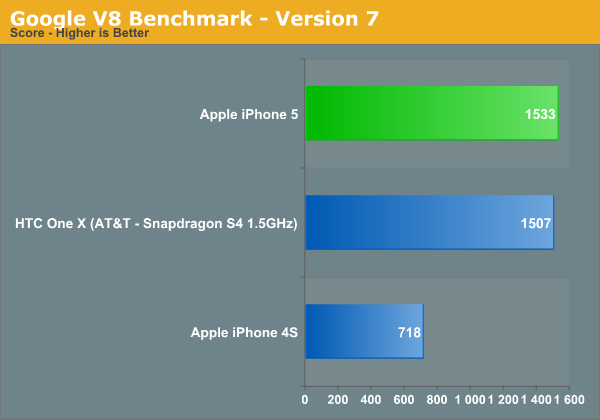
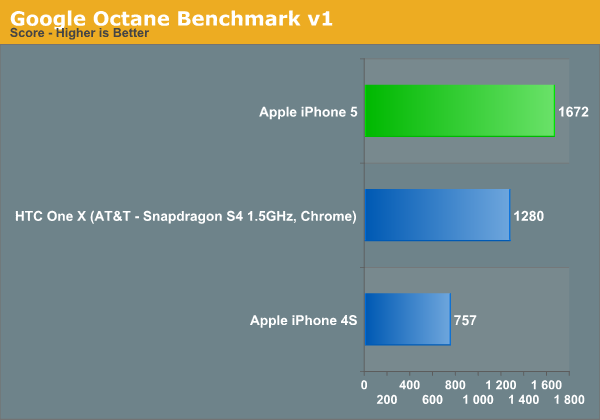
Here we see huge gains over the iPhone 4S, but much closer performance to the One X. In the case of Google's V8 benchmark the two phones are effectively identical, although Octane gives the iPhone 5 a 30% lead once more.
These are still narrowly focused tests, we'll be doing some more holisitic browser tests over the coming days. Finally we have Geekbench 2, comparing the iPhone 5 and 4S:
| Geekbench 2 Performance | ||||
| Geekbench 2 Overall Scores | Apple iPhone 4S | Apple iPhone 5 | ||
| Geekbench Score | 628 | 1640 | ||
| Integer | 545 | 1252 | ||
| Floating Point | 737 | 2101 | ||
| Memory | 747 | 1862 | ||
| Stream | 299 | 946 | ||
Apple claimed a 2x CPU performance advantage compared to the iPhone 4S during the launch event for the 5. How does that claim match up with our numbers? Pretty good actually:
This is hardly the most comprehensive list of CPU benchmarks, but on average we're seeing the iPhone 5 deliver 2.13x the scores of the iPhone 4S. We'll be running more application level tests over the coming days so stay tuned for those.
A6 GPU Performance: Nearly Identical to the iPad 3
Before we got a die shot of Apple's A6 we had good information pointing to a three core PowerVR SGX 543MP3 in the new design. As a recap, Imagination Technologies' PowerVR SGX543 GPU core features four USSE2 pipes. Each pipe has a 4-way vector ALU that can crank out 4 multiply-adds per clock, which works out to be 16 MADs per clock or 32 FLOPS. Imagination lets the customer stick multiple 543 cores together, which scales compute performance linearly. The A5 featured a two core design, running at approximately 200MHz based on our latest news. The A5X in the 3rd generation iPad featured a four core design, running at the same 200MHz clock speed.
The A6 on the other hand features a three core PowerVR SGX 543MP3, running at higher clock speeds to deliver a good balance of die size while still delivering on Apple's 2x GPU performance claim. The raw specs are below:
| Mobile SoC GPU Comparison | |||||||||||
| Adreno 225 | PowerVR SGX 540 | PowerVR SGX 543MP2 | PowerVR SGX 543MP3 | PowerVR SGX 543MP4 | Mali-400 MP4 | Tegra 3 | |||||
| SIMD Name | - | USSE | USSE2 | USSE2 | USSE2 | Core | Core | ||||
| # of SIMDs | 8 | 4 | 8 | 12 | 16 | 4 + 1 | 12 | ||||
| MADs per SIMD | 4 | 2 | 4 | 4 | 4 | 4 / 2 | 1 | ||||
| Total MADs | 32 | 8 | 32 | 48 | 64 | 18 | 12 | ||||
| GFLOPS @ 200MHz | 12.8 GFLOPS | 3.2 GFLOPS | 12.8 GFLOPS | 19.2 GFLOPS | 25.6 GFLOPS | 7.2 GFLOPS | 4.8 GFLOPS | ||||
| GFLOPS As Shipped by Apple/ASUS | - | - | 12.8 GFLOPS | 25.5 GFLOPS | 25.6 GFLOPS | - |
12 GFLOPS |
||||
The result is peak theoretical GPU performance that's near identical to the A5X in the 3rd generation iPad. The main difference is memory bandwidth. The A5X features a 128-bit wide memory interface while the A6 retains the same 64-bit wide interface as the standard A5. In memory bandwidth limited situations, the A5X will still be quicker but it's quite likely that at the iPhone 5's native resolution we won't see that happen.
We ran through the full GLBenchmark 2.5 suite to get a good idea of GPU performance. Note that the 3rd gen iPad results are still on iOS 5.1 so there's a chance you'll see some numbers change as we move to iOS 6.
We'll start out with the raw theoretical numbers beginning with fill rate:
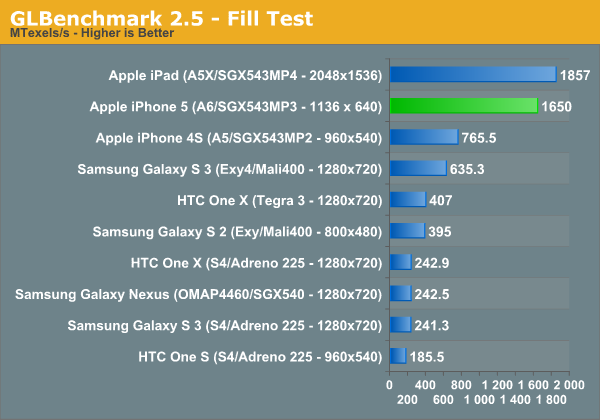
The iPhone 5 nips at the heels of the 3rd generation iPad here, at 1.65GTexels/s. The performance advantage over the iPhone 4S is more than double, and even the Galaxy S 3 can't come close.
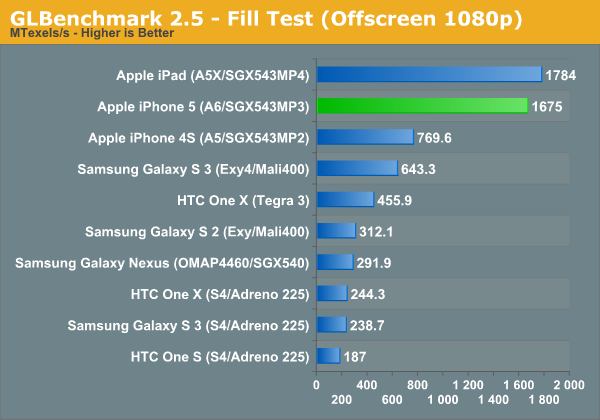
Triangle throughput is similarly strong:
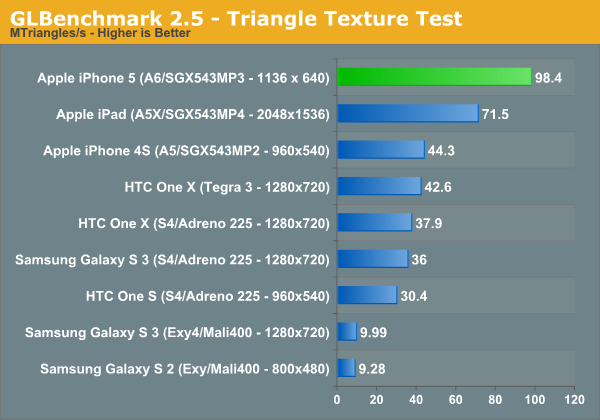
Take resolution into account and the iPhone 5 is actually faster than the new iPad, but normalize for resolution using GLBenchmark's offscreen mode and the A5X and A6 look identical:
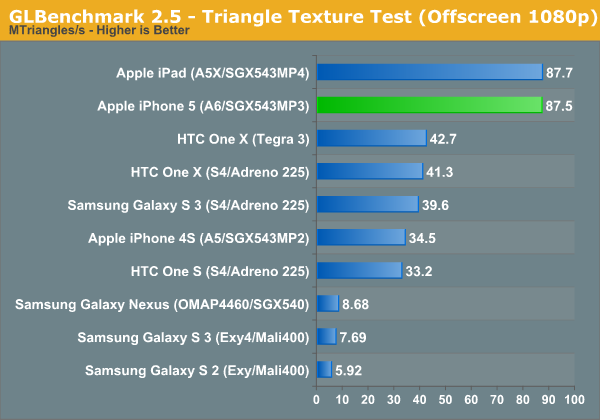
The fragment lit texture test does very well on the iPhone 5, once again when you take into account the much lower resolution of the 5's display performance is significantly better than on the iPad:
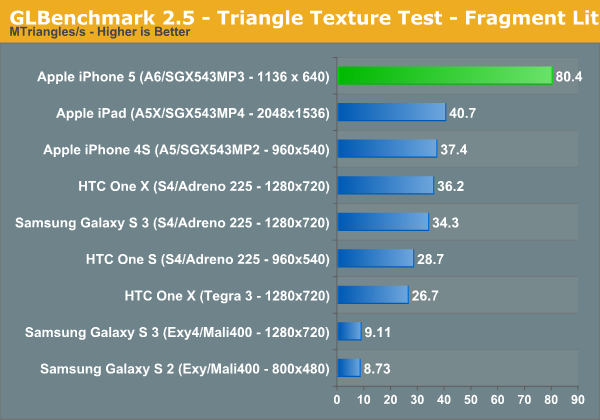
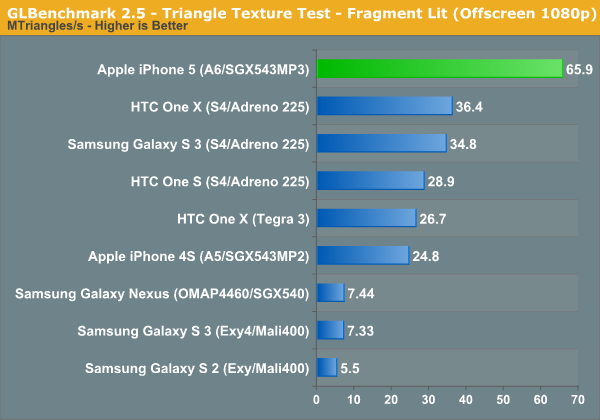
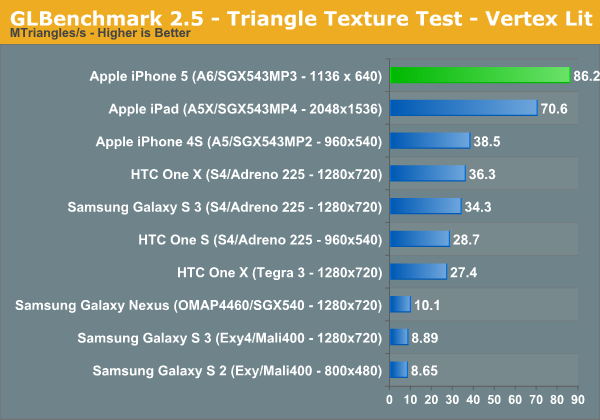
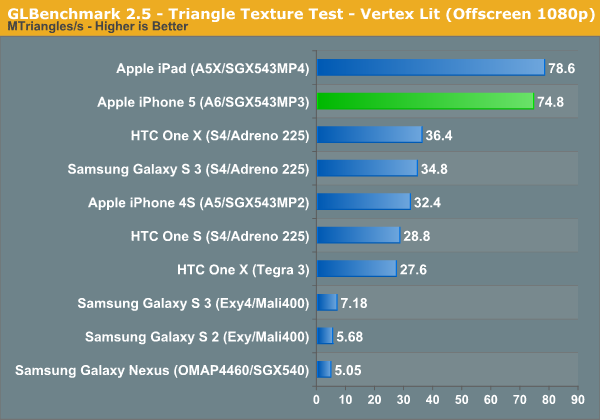
The next set of results are the gameplay simulation tests, which attempt to give you an idea of what game performance based on Kishonti's engine would look like. These tests tend to be compute monsters, so they'll make a great stress test for the iPhone 5's new GPU:
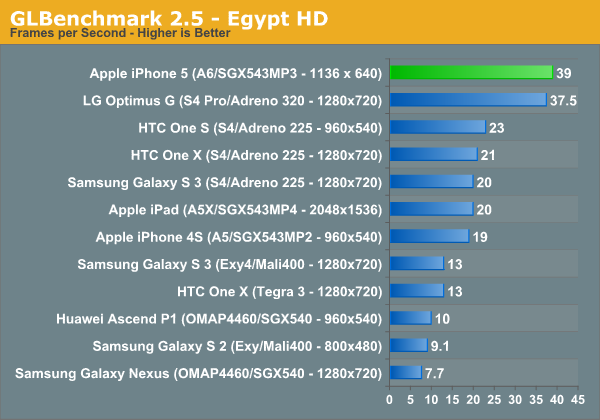
Egypt HD was the great equalizer when we first met it, but the iPhone 5 does very well here. The biggest surprise however is just how well the Qualcomm Snapdragon S4 Pro with Adreno 320 GPU does by comparison. LG's Optimus G, a device Brian flew to Seoul, South Korea to benchmark, is hot on the heels of the new iPhone.
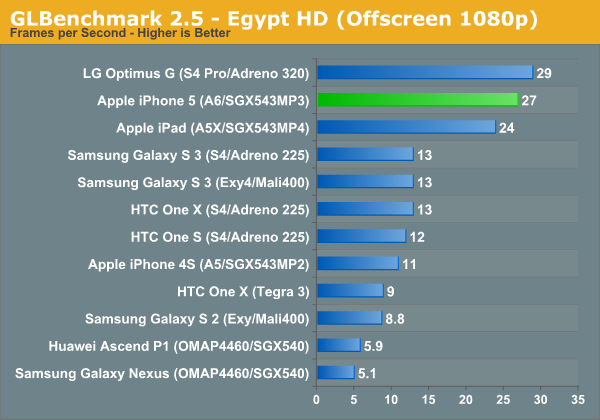
When we run everything at 1080p the iPhone 5 looks a lot like the new iPad, and is about 2x the performance of the Galaxy S 3. Here, LG's Optimus G actually outperforms the iPhone 5! It looks like Qualcomm's Adreno 320 is quite competant in a phone.
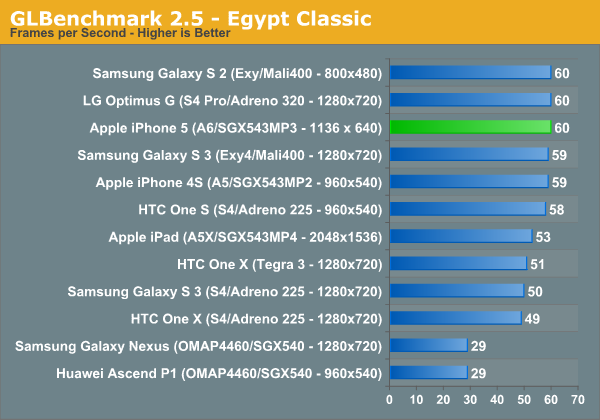
The Egypt classic tests are much lighter workloads and are likely a good indication of the type of performance you can expect from many games today available on the app store. At its native resolution, the iPhone 5 has no problems hitting the 60 fps vsync limit.

Remove vsync, render at 1080p and you see what the GPUs can really do. Here the iPhone 5 pulls ahead of the Adreno 320 based LG Optimus G and even slightly ahead of the new iPad.
Once again, looking at GLBenchmark's on-screen and offscreen Egypt tests we can get a good idea of how the iPhone 5 measures up to Apple's claims of 2x the GPU performance of the iPhone 4S:
Removing the clearly vsync limited result from the on-screen Egypt Classic test, the iPhone 5 performs about 2.26x the speed of the 4S. If we include that result in the average you're still looking at a 1.95x average. As we've seen in the past, these gains don't typically translate into dramatically higher frame rates in games, but games with better visual quality instead.
Final Words
We still have a lot of work ahead of us, including evaluating the power profile of the new A6 SoC. Stay tuned for more data in our full review of the iPhone 5.


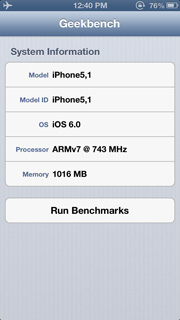

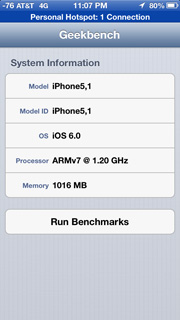












237 Comments
View All Comments
manders2600 - Saturday, September 22, 2012 - link
Also, just clocked my GNex to 1.4 GHz and scored 1525 on Octane, basically doubling the 4S's perfs and about 25% higher than the Krait listed.Since there's no way the GNex is faster that the S4 when clocked 100 MHz lower, my best guess would be that the difference is in the OS version (JB vs ICS).
serversurfer - Saturday, September 22, 2012 - link
Apple sell the 4S with 6.0 installed on it. Do Verizon sell the Nexus with Jellybean pre-installed?These phones are tested as they come out of the box. They're testing the performance of the phones as sold, not their own ability to tweak them.
manders2600 - Saturday, September 22, 2012 - link
It's an OTA update that started rolling out today. Much the same as the update for the iPhone 4S to iOS 6.0Also, minor updates with performance enhancements have been issued over the past year the phone has been available. If these benchmarks were run in December of 2011, when the phone was first released, they would not be applicable to the phone today, just as an iOS 5.0 benchmark would not be applicable to the iPhone 4S today.
teiglin - Saturday, September 22, 2012 - link
Not to mention, said Jelly Bean update has been available to GSM Galaxy Nexus users for months, as well as to more enterprising users of toro[plus].I agree that dating these benchmarks should be a requirement, and re-running them (at least for flagship devices/major updates, like JB on the Nexus) would be hugely valuable. Especially for benchmarks like Sunspider, where software optimization is just as relevant as the SoC in question.
All that said, I'm pretty jealous of A6 users. Those of us who don't want everything that goes with buying into Apple are stuck waiting for S4 Pro (hopefully soon) or TI/Exynos A15s (god only knows when).
serversurfer - Saturday, September 22, 2012 - link
So, given the lack of a direct response to my question, am I to assume a direct response would be something along the lines of, "No, they don't sell it with Jellybean, and while I now understand why only certain benchmarks are updated, I still don't like it"?manders2600 - Saturday, September 22, 2012 - link
No, the response would be that the GSM models ARE sold with Jellybean, and the VZW model updates to Jellybean as soon as you activate it.Impulses - Sunday, September 23, 2012 - link
In a couple of weeks or a month at worst (the update came out recently) I'm sure VZ will be selling them with the update already on board. Then again, a month or two from now they might be selling the next Nexus. :p1008anan - Saturday, September 22, 2012 - link
I was surprised by many things:--how good the A6 cores are
--how good the PowerVR SGX543MP3 graphics are
--how good the Adreno 320 and 4 Krait Cores performed (in Brian's LG Optimus G)
How much of the iphone 5's outstanding performance was due to its improved operating system and middleware versus hardware? For the results to be this uniformly good, didn't at least some of the improvement have to have come from improved software?
Anand Shimpi, thank you very much for the Mobile SoC GPU Comparison chart and the easy to understand explanation regarding how the SGX543MP3 GPU works.
Some questions for you if I could:
" Imagination Technologies' PowerVR SGX543 GPU core features four USSE2 pipes. Each pipe has a 4-way vector ALU that can crank out 4 multiply-adds per clock, which works out to be 16 MADs per clock or 32 FLOPS."
Please explain to me why 16 MADs per clock (I understand where that comes from) results in 32 Flops per clock? How can 1 MAD per cycle result in 2 flops per cycle? What am I not understanding?
"Imagination lets the customer stick multiple 543 cores together, which scales compute performance linearly."
How close to linear is it? Is the performance of three 543 cores = 2.8 times the performance of one 543 core? 2.9 times? Or some other number?
"The A5 featured a two core design, running at approximately 200MHz based on our latest news. The A5X in the 3rd generation iPad featured a four core design, running at the same 200MHz clock speed. The A6 on the other hand features a three core PowerVR SGX 543MP3, running at higher clock speeds to deliver a good balance of die size while still delivering on Apple's 2x GPU performance claim. The raw specs are below:"
Is the clock speed of the 543MP3 = [25.5 Gigahertz/19.2 Gigahertz]*200 Megahertz = 266 Megahertz?
From the Mobile SoC GPU Comparison chart, the 543MP3 has 12 SIMDs (3 graphics cores multiplied by 4 SIMDs per core). Each SIMD has 4 MADs. Therefore the 543MP3 has 48 MADs = (3 graphics cores multiplied by 4 SIMDs per core multiplied by 4 MADs per SIMD). Since each MAD has 2 flops per clock, the total number of flops is 96 per clock for the 543MP3. Multiply 266 Megahertz by 96 flops per clock and we get 25.5 gigaflops. This math computes.
Are the 48 MADs all 64 bit? Which results in two flops per MAD? Or is there some other explanation?
Many thanks in advance for your help and the help of the many commentators on this blog.
kfishy - Saturday, September 22, 2012 - link
I presume that 1 MAD equals 2 FLOPS because a MAD is algorithmically decomposed into a multiply and an add in terms of raw computation. In hardware however the multiply and the addition/accumulation would be performed in a single cycle.Lucian Armasu - Saturday, September 22, 2012 - link
Glad to see you're finally including other JS tests, as Sunspider was really getting long in the tooth. It reminds me of when the A5 scored like 4-5x in graphics over other phones in other simple graphics tests before. But those are kind of irrelevant. We need more complex tests that show a more realistic difference in performance between different devices and chips.So I'm glad you've included the V8 test, which was specifically made by Google as an alternative to Sunspider and as a much more complex and realistic test of Javascript performance. Google has been saying Sunspider is irrelevant and they won't optimize for it anymore for about a year now. That might be why Chrome tests even lower than the stock browser in some Sunspider tests. Although it's still strange Chrome score lower in V8 as well compared to the stock browser. I think Google is not where they want to be with Chrome for Android yet. Hopefully the next version of Android that will be unveiled this November and the next version of Chrome will fix that.
What's your conclusion on why the A6 CPU is so fast in these tests? Does it really have much higher IPC than Krait? Or is it because memory was a bottleneck for Krait, and Apple fixed that in the new iPhone 5? Should we expect higher performance from Krait as well when paired with better memory?
I'm also looking forward for you to test Samsung's Exynos 5 Dual with Cortex A15 and Mali T604. No idea why Samsung is dragging its feet and not releasing it with a device already.